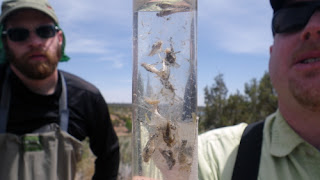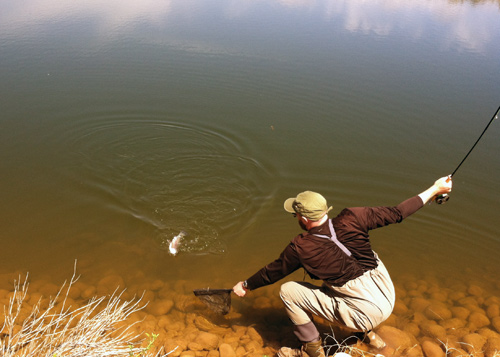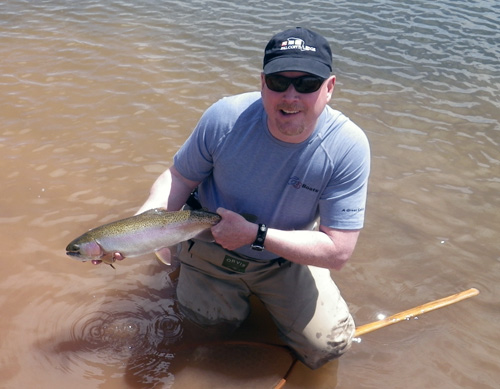Written by: Phil Rowley, Fly Craft Angling
Phil Rowley hoists a fine Falcon’s Ledge rainbow caught using the “naked” technique.
All photos courtesy Phil Rowley
A few years ago, I was in Utah at Falcon’s Ledge for another of my stillwater schools. Callibaetis and damselflies were active on the lodge lakes. The fishing was so good that Falcon’s Ledge guide and friend, Grant Bench, and I were busy every evening replenishing lost flies for everyone.
With each on-the-water seminar, a specific opportunity or presentation technique typically steps to the front. This time, the Callibaetis and damsel activity provided the perfect recipe for what I call the “naked” technique—a floating line coupled with a long, 15 feet or greater, leader.
Floating lines and strike indicators dominate stillwater fly fishing today, and I use them often. And for good reason, as it can be a deadly method. But there is more to fly fishing lakes than hanging flies under indicators. There are other presentation techniques, such as the naked technique, that all stillwater fly fishers should learn.

Callibaetis nymphs were on the menu.
Nicknamed for its lack of an indicator, the naked technique is the traditional method I that learned for fishing chironomid pupae and larvae (bloodworms). Of course, strike indicators didn’t exist when i was growing up. But I firmly believe that all stillwater fly fishers should learn how to fish flies using a floating line and a long leader, as it teaches two critical stillwater skills—patience and touch. These are skills that, once developed, improve all aspects of your stillwater presentation.
When fishing the naked technique, a floating line with a large head profile suited for casting long leaders. I want a leader system with a stiff butt section to aid turnover and long tippet section to sink flies quickly. I begin by attaching approximately three feet of butt section that is just thicker than the butt section of my knotless, tapered leader. Attach the butt section to the slender line loop via a clinch knot, and then attach the 10-foot leader using a blood knot, as this provides a smooth horizontal profile that travels through the guides easily. To complete the overall leader length, simply add fluorocarbon tippet using a triple surgeon’s knot. The leader must be 25% longer than the water is deep, as the leader doesn’t sink straight off the end of the fly line. So to fish 16 feet down, for example, requires a 20-foot leader.
Keep your false casts to a minimum, break your wrist slightly to facilitate an open loop, and remember the properties of a weight-forward line. Shoot the line to the target. I never false cast more than twice. Repeated false casts are asking for tangles. As the line shoots out and reaches the end of the cast, let the line shoot tight to the reel or pinch it to a stop. This causes the flies to slingshot over, aiding leader turnover. Get in the habit of looking for distinct splashes when you’re fishing multiple flies. If they land within close proximity to each other strip them in and investigate, as you probably have the makings of a tangle. When using multiple flies, I keep them 3-5 feet apart depending on water clarity: the clearer the water the greater the separation. This slingshot technique also works well with indicators.

When you’re using a very long leader, your knots must slide
easily through the guides, or landing a fish becomes a problem.
Once the line hits the water, strip out any slack and let the flies sink. Thirty seconds is standard. Use your watch to ensure accuracy. For many anglers, waiting 30 seconds is agony. Remember that learning to have some patience is a by-product of this method. Once your flies are sunk, use two brisk 3-inch strips to remove any slack and perhaps draw a nearby fish to the fly. If there are no takers, begin a slow—and I mean slow—hand-twist retrieve. During the retrieve, there must be no surface wake caused by the fly line. . .more agony for the impatient.
Complete line control is critical when using the naked technique. This means double-anchoring when you’re fishing from a boat or pontoon boat. You must turn your watercraft into essentially dry land. Any sway means loss of line control and retrieve. You have to stay tight to the flies to be successful.
Your fly line is a 90-foot strike indicator. Watch it, particularly the tip region closest to the fly, like a hawk for signs of a take. If the line veers left, right, or downward, raise the rod to set the hook. If there is a little squiggle in the fly line, watch it closely. If it suddenly straightens, raise the rod. In calm conditions, you will almost always see takes before you feel them. The elevated banks of many of the lakes at Falcon’s Ledge provided a perfect vantage point when I demonstrated the method. Students saw the line move as fish inhaled the fly below. I couldn’t have asked for a better demonstration. To drive my point home, on two occasions during my presentation, I hooked and landed two fish twice.

Rowley is flanked by guides Spencer Higa (left) and Grant Bench.
If I were limited to once presentation technique for lakes, it would be without a doubt be fishing floating lines and long leaders, particularly if I am working water between 14 and 18 feet where this method shines. I encourage you to give the naked technique a try.
Phil Rowley is a well-known stillwater specialist from Alberta, Canada. He owns Fly Craft Angling.
Credit: Source link































